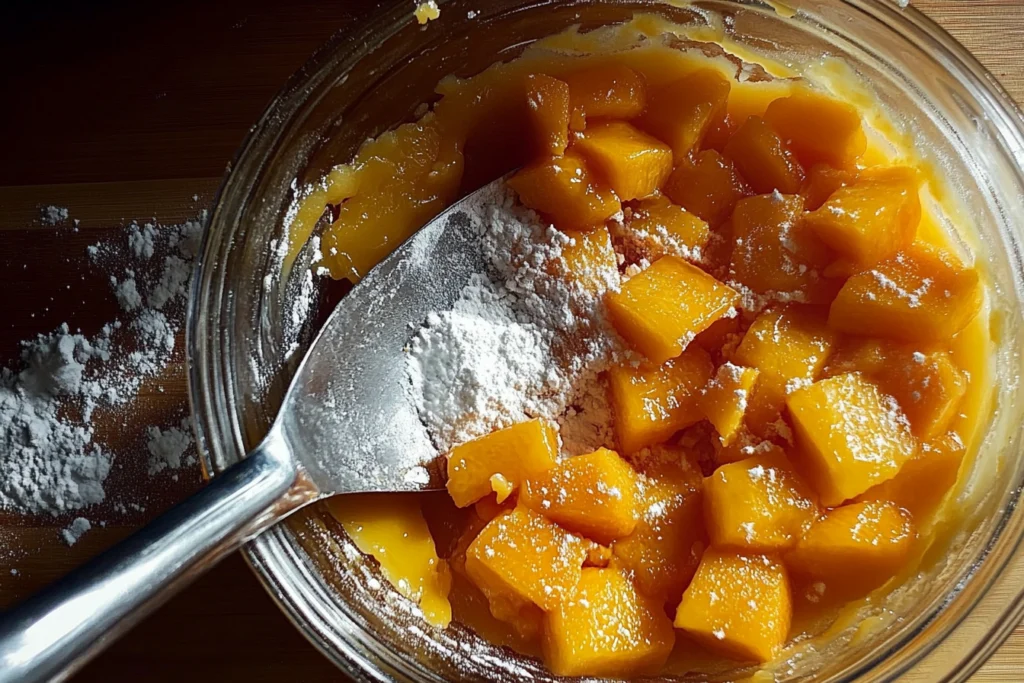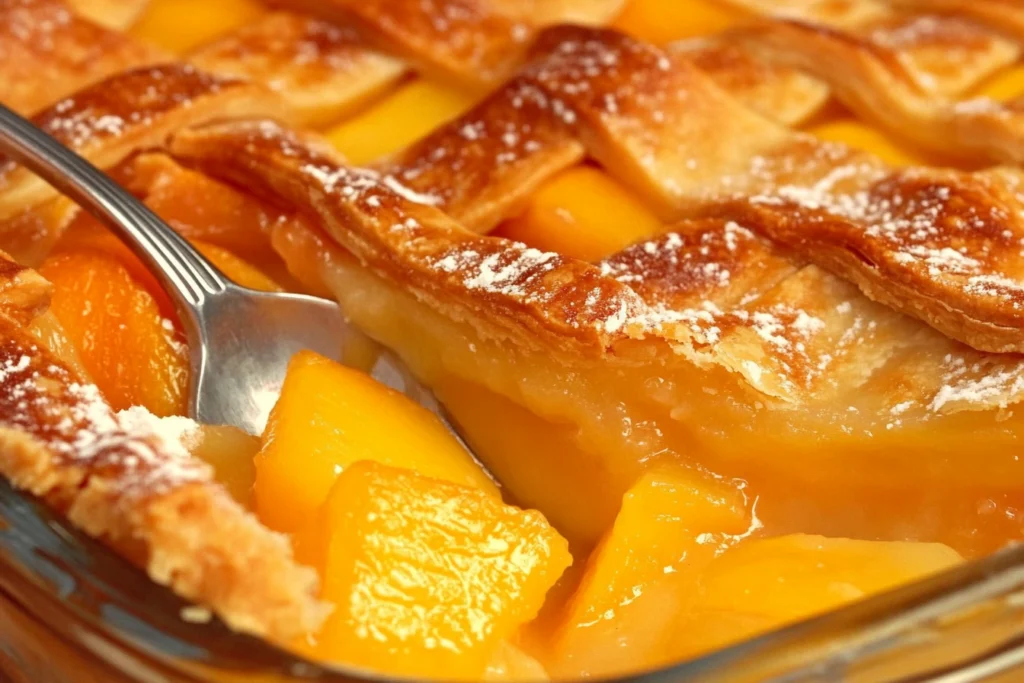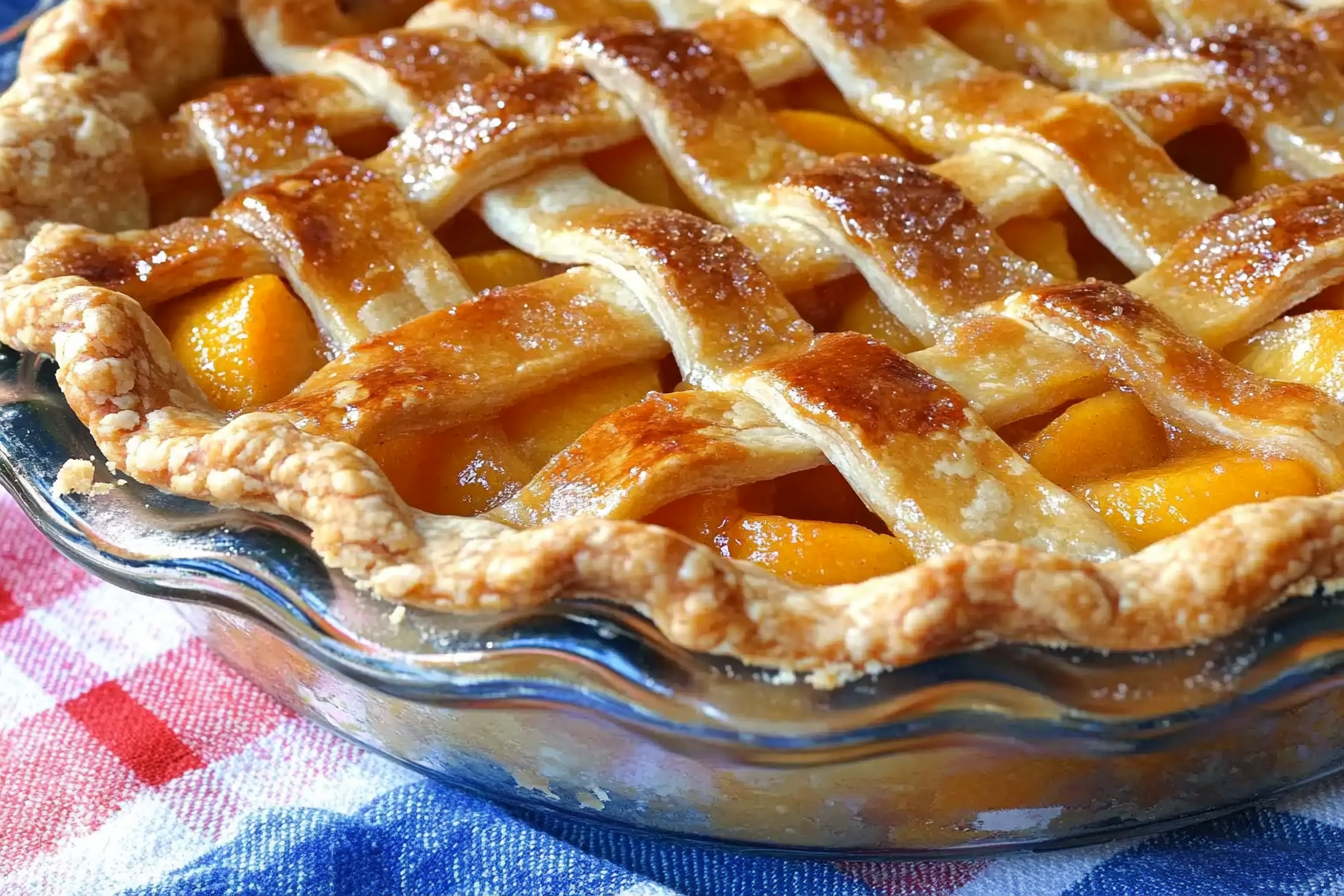Peach pie is a beloved dessert, celebrated for its balance of sweet, tangy, and fruity flavors. However, one common frustration when baking a peach pie is achieving the perfect filling consistency. A runny peach pie can be disappointing, but understanding the causes and solutions ensures your pie is as delightful as it should be.
Part 1: Understanding the Problem
Why Do Peach Pies Become Runny?
Natural Juiciness of Peaches
Peaches are naturally high in water content. While this is what makes them juicy and flavorful, it also presents a challenge for bakers. During baking, the heat draws out these juices, and if not properly managed, the pie filling becomes watery rather than luscious.
Common Mistakes in Pie Preparation
Some bakers unintentionally set themselves up for failure by:
- Using overripe or unripe peaches.
- Skipping thickening agents or using the wrong kind.
- Overloading the pie with too much fruit, which amplifies the liquid content.
Importance of Proper Thickening Agents
Thickening agents like cornstarch, tapioca, or flour are vital for transforming liquid into a cohesive filling. Without these, the juices remain unbound, causing the pie to lose structure.
Variability in Peach Ripeness
The ripeness of peaches significantly impacts their water content. Overripe peaches release more juice, while underripe ones lack the sweetness and flavor needed for a balanced pie.
Overlooking Pie Cooling Times
Patience is key. Cutting into a pie before it has cooled allows the filling to spill out, as it hasn’t had time to set. Cooling ensures the thickening agents fully activate and bind the juices.
The Science of Pie Filling Consistency
How Juices Release During Baking
When heat is applied, the cell walls of the fruit break down, releasing water. This is a natural process, but when combined with sugar, it can intensify as sugar draws out even more liquid through osmosis.
Role of Heat and Evaporation
Baking not only cooks the pie but also evaporates excess moisture. However, improper baking temperatures or times can leave too much liquid behind.
Chemical Reactions in Thickeners
Thickening agents react to heat and moisture:
- Cornstarch: Forms a gel-like structure when exposed to heat.
- Tapioca: Absorbs liquid efficiently, creating a smooth texture.
- Flour: Thickens but may leave a cloudy appearance.
Understanding how these work helps in choosing the right one for your pie.
Ingredients That Contribute to a Watery Pie
Overripe or Frozen Peaches
- Overripe peaches contain excess water and are less firm.
- Frozen peaches retain moisture during freezing, releasing it as they thaw. Without proper draining, this liquid contributes to a runny filling.
Inadequate Use of Sugar
Sugar plays a dual role. While it enhances sweetness, using too much can draw out more liquid than necessary. This imbalance leaves the filling overly wet.
Skipping Acidic Balancing Agents
Acids like lemon juice not only balance sweetness but also help firm up the fruit. Without this step, the filling may lack structure.
Part 2: Preventing a Runny Peach Pie
Choosing the Right Peaches
How to Select the Best Fresh Peaches
Opt for peaches that are:
- Firm yet slightly soft to the touch.
- Free from bruises or overly mushy spots.
- Fragrant, indicating ripeness without being overripe.
When to Use Canned or Frozen Peaches
Canned and frozen peaches can be substitutes, but they require extra care:
- Drain canned peaches thoroughly.
- Thaw frozen peaches and blot them with paper towels to remove excess moisture.
Prepping Peaches to Control Juices
Sprinkling sliced peaches with a small amount of sugar and letting them rest draws out excess juice. This juice can be discarded or reduced separately and added back to the filling for a more concentrated flavor.
Using the Right Thickening Agent
Comparing Cornstarch, Tapioca, and Flour
- Cornstarch: Best for a clear, glossy filling.
- Tapioca: Creates a silky, firm texture ideal for fruit pies.
- Flour: A traditional thickener, though it can produce a denser texture.
Tips for Properly Mixing Thickeners
Mix the thickening agent with sugar before incorporating it into the fruit. This prevents clumping and ensures even distribution.
How Much Thickener to Use Per Cup of Fruit
- Cornstarch: 1 tablespoon per cup of peaches.
- Tapioca: 1.5 teaspoons per cup.
- Flour: 2 tablespoons per cup.
These proportions vary based on peach ripeness and water content.
Balancing Ingredients for the Perfect Filling
Role of Sugar in Absorbing Juices
Sugar helps bind water molecules, reducing excessive liquid in the filling. The key is using just enough to enhance sweetness without oversaturating the mixture.
Adding Lemon Juice for Acidity
A splash of lemon juice heightens the flavor while preventing the filling from becoming overly sweet. Acidity also helps stabilize the texture.
Enhancing Flavor While Controlling Moisture
Spices like cinnamon or nutmeg and extracts like vanilla add depth without affecting moisture levels. Experimenting with these can elevate your pie while maintaining consistency.

Adjusting the Baking Process
Pre-Baking Pie Shells to Prevent Sogginess
Blind baking (pre-baking the crust) ensures a crisp base. Use pie weights to keep the shell flat during the process.
Baking at the Right Temperature
Start baking at a higher temperature (400°F) to encourage initial thickening, then lower to 350°F to finish. This method ensures the filling sets without overcooking.
Monitoring the Pie for Doneness
A perfectly baked pie has bubbling juices visible through the vents and a golden-brown crust. Underbaking leaves the filling runny, while overbaking dries it out.
How to Keep a Peach Pie from Being Runny (Part 2)
In Part 1, we explored the challenges of making a perfectly consistent peach pie and the underlying causes of a runny filling. In Part 2, we’ll dive into actionable tips for preventing a runny peach pie and enhancing its overall quality.
Choosing the Right Peaches
How to Select the Best Fresh Peaches
The foundation of any great peach pie lies in selecting the right peaches. Look for:
- Firm, ripe peaches: These are sweet but still hold their structure during baking.
- Freestone varieties: Easier to work with than clingstone peaches as the pits come out cleanly.
- Seasonal peaches: Always aim for in-season fruit to ensure optimal flavor and texture.
Avoid overly ripe peaches as they contain too much water, which can make the pie filling runny.
When to Use Canned or Frozen Peaches
Sometimes fresh peaches aren’t available, and canned or frozen options can save the day:
- Canned peaches: Opt for those packed in juice or water rather than syrup to avoid excessive sweetness. Drain them thoroughly.
- Frozen peaches: Thaw them completely and drain the liquid. Pat them dry with paper towels to remove residual moisture before use.
Prepping Peaches to Control Juices
Prepping peaches properly is essential for managing their juiciness:
- Slice the peaches evenly to ensure consistent cooking.
- Sprinkle them with sugar and allow them to sit for 10–15 minutes. This process, called maceration, draws out some liquid.
- Drain the excess liquid and consider reducing it in a saucepan for a flavorful syrup to add back into the filling.
Using the Right Thickening Agent
Comparing Cornstarch, Tapioca, and Flour
Choosing the right thickener depends on your desired texture:
- Cornstarch: Ideal for a shiny, smooth filling. Works well with peaches but requires careful measurement to avoid a gluey texture.
- Tapioca (instant or pearl): Known for its silky, firm results. It holds up well with high moisture fruits like peaches.
- Flour: A classic option but can result in a slightly cloudy filling. Use it if you prefer a more rustic pie.
Tips for Properly Mixing Thickeners
To avoid clumps and uneven thickening:
- Mix the thickener with sugar before combining it with the peaches.
- Stir the mixture thoroughly to ensure even coating of the fruit.
- Avoid adding thickeners directly to wet fruit without blending with dry ingredients.
How Much Thickener to Use Per Cup of Fruit
Getting the proportions right ensures the filling is neither too runny nor overly thick:
- Cornstarch: Use 1 tablespoon per cup of peaches.
- Tapioca: Use 1.5 teaspoons per cup.
- Flour: Use 2 tablespoons per cup.
Remember to adjust based on the peaches’ water content and ripeness.
Balancing Ingredients for the Perfect Filling
Role of Sugar in Absorbing Juices
Sugar is a key player in pie filling consistency. It:
- Balances the natural tartness of peaches.
- Draws out moisture during maceration, helping to control liquid content.
- Helps the thickening agent distribute evenly.
Adding Lemon Juice for Acidity
A splash of lemon juice not only enhances the pie’s flavor but also:
- Balances the sweetness of the sugar.
- Reacts with the thickener to stabilize the filling.
- Prevents browning of the peaches during preparation.
Enhancing Flavor While Controlling Moisture
To achieve a pie filling that is both flavorful and well-structured:
- Use spices like cinnamon, nutmeg, or ginger sparingly to complement the peaches.
- Add vanilla or almond extract for a deeper flavor profile.
- Avoid liquid flavorings like peach schnapps, which can contribute to excess moisture.
Adjusting the Baking Process
Pre-Baking Pie Shells to Prevent Sogginess
Blind baking your crust can significantly reduce sogginess:
- Line the crust with parchment paper or foil.
- Fill with pie weights, dried beans, or rice to prevent puffing.
- Bake for 10–15 minutes at 375°F, then cool before adding the filling.
Baking at the Right Temperature
Temperature control is crucial for proper thickening:
- Start with a higher temperature (400°F) to set the crust and filling.
- Lower to 350°F to ensure even baking and prevent overcooking.
Monitoring the Pie for Doneness
Signs of a perfectly baked pie include:
- Bubbling juices visible through the crust’s vents.
- A golden-brown crust.
- An aromatic, sweet scent filling your kitchen.
Avoid underbaking, as it leaves the filling runny, or overbaking, which can dry out the pie.
Additional Tips and Tricks
How to Drain Excess Juice from Peaches
Macerating peaches before baking is a simple yet effective technique:
- Toss sliced peaches with sugar and let them rest in a colander over a bowl.
- Collect the juice and reduce it over low heat until it thickens. Add it back to the peaches for extra flavor.
Adding a Bottom Crust Barrier
Prevent sogginess by creating a barrier between the filling and the crust:
- Brush the crust with an egg wash and bake for 5 minutes before adding the filling.
- Sprinkle a thin layer of breadcrumbs, crushed cookies, or a dusting of flour onto the crust before adding the fruit.
Layering the Ingredients Strategically
To distribute moisture evenly:
- Place the thickened filling at the bottom.
- Add smaller chunks of peaches on top.
- Top with a lattice or crumb crust to allow steam to escape.

Common Mistakes and How to Avoid Them
Using Too Much or Too Little Thickener
Finding the right balance is key. Too much thickener can lead to a pasty texture, while too little results in a watery filling. Always measure carefully.
Baking at the Wrong Temperature
Baking at too high or low a temperature impacts the filling’s consistency. Follow recommended guidelines and use an oven thermometer for accuracy.
Neglecting to Let the Pie Cool
Cutting into the pie too soon is one of the most common mistakes. Let the pie cool for at least 2–3 hours to allow the filling to set properly.
Recipes and Testing for Perfect Consistency
Tried-and-True Peach Pie Recipes
Experiment with recipes that balance sweetness, spices, and thickening agents. Always look for ones that have been reviewed and tested.
Testing the Pie Filling Before Baking
A quick stovetop test:
- Cook a small portion of the peach mixture in a saucepan.
- Adjust thickener or sugar based on the consistency of this test batch.
Adjusting Recipes for Personal Preferences
Tailor recipes to your taste:
- Add more sugar for sweeter pies.
- Use less sugar and more acid for a tart version.
- Incorporate spices or extracts to match your flavor preferences.
Serving the Perfect Peach Pie
Pairing the Pie with Ice Cream or Cream
A dollop of whipped cream or a scoop of vanilla ice cream enhances the flavor of a well-set pie.
Ensuring the Pie Holds Its Shape When Sliced
Use a sharp knife and wipe it between slices for clean cuts.
Storage Tips to Prevent Moisture Issues
Store leftover pie at room temperature for up to 2 days or refrigerate for up to 5 days. Cover the pie loosely to prevent the crust from becoming soggy.
ach pies will not only avoid runniness but also impress with their te
How to Keep a Peach Pie from Being Runny (Part 3)
In Parts 1 and 2, we explored the causes of runny peach pies and essential techniques to achieve perfect consistency. In this final section, we’ll focus on advanced tips, common mistakes, and solutions to ensure your peach pies are always flawless.
Advanced Techniques for a Perfect Peach Pie
Draining Excess Juice
Peaches naturally release a lot of liquid during baking. Managing this excess moisture is critical:
- Macerate the Fruit: Toss sliced peaches with sugar and allow them to sit in a colander over a bowl for about 20 minutes. This process draws out excess moisture without sacrificing flavor.
- Reduce the Collected Juice: Simmer the drained juice on the stove until it thickens into a syrup, then add it back to the filling for concentrated peach flavor.
Preventing a Soggy Bottom Crust
The crust often absorbs moisture from the filling, leading to a soggy texture. To prevent this:
- Blind Bake the Crust: Pre-bake the crust with pie weights for 10–15 minutes to set it before adding the filling.
- Create a Barrier: Brush the crust with an egg wash or melted butter and bake briefly to seal it. Alternatively, sprinkle a layer of fine breadcrumbs, crushed cookies, or cornstarch onto the crust before adding the filling. These absorb excess moisture during baking.
Layering Ingredients Strategically
Distributing the filling in layers ensures even moisture control:
- Place a small portion of thickened filling or peach chunks at the bottom.
- Add the remaining fruit evenly, leaving room for the lattice or crumb topping. The topping allows steam to escape, preventing excess liquid buildup.
Common Mistakes and How to Avoid Them
Too Much or Too Little Thickener
Getting the right balance of thickener is essential. Use these guidelines:
- Cornstarch: 1 tablespoon per cup of peaches for a glossy, cohesive filling.
- Tapioca: 1.5 teaspoons per cup, ideal for a smooth and firm texture.
- Flour: 2 tablespoons per cup for a traditional option, though it may produce a denser filling.
Too much thickener results in a gummy texture, while too little leaves the pie runny.
Skipping the Cooling Step
One of the most common mistakes is cutting into the pie too soon. Allow the pie to cool for at least 2–3 hours to let the filling set. For the best results, let it cool overnight, especially if you plan to serve it sliced.
Baking at Incorrect Temperatures
Proper baking ensures the filling thickens and the crust doesn’t burn. Bake at 400°F for the first 15 minutes to set the crust and activate the thickener. Then, reduce to 350°F and bake until the filling bubbles and the crust is golden-brown.
Final Tips for Peach Pie Success
- Choose the Right Peaches: Use firm, ripe peaches for the best texture and flavor. Overripe peaches release too much liquid, while underripe ones lack sweetness.
- Add Acid for Balance: A splash of lemon juice enhances flavor and helps stabilize the filling.
- Test the Filling: Cook a small portion of the filling on the stove to check consistency before baking the pie.
By mastering these techniques, you can ensure your peach pies are perfectly set, flavorful, and visually stunning every time. Whether serving at a family gathering or enjoying a slice at home, your peach pie will be the highlight of the dessert table.
Related Article : What is the difference between a peach pie and a peach cobbler?

